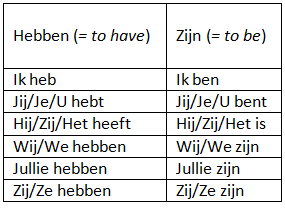Dutch personal pronouns and the verb. A worksheet on the personal pronouns, the present tense, the verbs “hebben” and “zijn”, the word order in the Dutch sentence and the imperative.
Dutch personal pronouns and the verb
The below table delineates the basic Dutch personal pronoun system:
| Nominative | Accusative | ||
| Ik | I | Mij /me | Me |
| Jij/je | You | Jou/je | You |
| U | You (formal) | U | You (formal) |
| Hij/-ie | He | Hem | Him |
| Zij/ze | She | Haar | Her |
| Het | It | Het | It |
| Wij/We | We | Ons | Us |
| Jullie | You (plural) | Jullie | You (plural) |
| Ze | They | Hen/Ze | Them |
For the most part, Dutch personal pronouns follow a similar pattern to English. They have the same distinctions for masculine, feminine and neuter and for first, second and third person. They also have the same distinctions for nominative and accusative, depending on whether the pronoun is used as subject or object of the clause.
Some Dutch pronouns have two versions as outlined in the table below:
| Jij/je | You |
| Hij/-ie | He |
| Zij/ze | She/they |
| Wij/we | We |
These are generally interchangeable, but the first variant can be used for emphasis or when introducing the person for the first time. The exception is the ie variant of ‘he’, which can only be used in subordinate constructions, such as in subordinate clauses or in questions. It is usually marked with a dash in order to show that it is not a typical pronoun. This construction is very informal.
Komt-ie?
‘Is he coming?’
Ik ben bang dat-ie weg is.
‘I’m afraid he has gone’
The distinction between u en jij.
Both u and jij mean ‘you’ (singular), but u is the more formal variant. Theoretically, u is used when addressing people you do not know, or with clients or people in authority. However, Dutch culture is generally quite egalitarian and it rare to hear u in everyday speech. You might use it when interacting with a client, for example, but even then, this might only be restricted to the first interaction. By the end of the conversation, it is common to have switched to jij entirely. Young people tend always to use jij with each other.
The Present Tense
The Dutch are keen users of the present tense. They even use it to refer to the future or hypothetical (conditional) sentences.
| ik | [stem] | we | infinitive |
| je | [stem] + t | jullie | infinitive |
| hij | [stem] + t | ze | infinitive |
The simple present tense is used in four cases:
- to refer to a momentary action that coincides with the moment we are talking about it
- to refer to an ongoing, habitual, or repetitive action or state
- to refer to a future event (in combination with an adverb of time)
- to refer to a hypothetical ‘if – then’ situation

The Dutch word order
Those of you who have already struggled with the Dutch word order probably know that the basic order of a Dutch main clause is as follows:
subject | finite verb | time | manner | place | other verbs
For example:
| subject | finite verb | time | manner | place | other verb(s) |
| Ik | heb | vanmorgen | met tegenzin | in de sportschool | getraind |
met tegenzin = reluctantly, unwillingly ; de sportschool = the gym
In general, this word order is correct. However, it is a severe over-simplification of reality: most sentences contain more than just the components mentioned above. What would we do, for example, with the direct object? The indirect object? The reflexive pronoun? And so on. Further, the time-manner-place order can vary according to the type of time, manner and place you use.
The imperative
For the imperative, we use the present tense of the 1st person singular. For regular verbs, this is the verb stem.
| Ga weg! | Go away! |
| Gooi dat maar weg. | Just throw that away. |
| Neem dat mee. | Take that with you. |
| Kom eens mee. | Just come here. |
The verb zijn has an irregular imperative. Instead of ben (1st person singular), we use the stem of the verb wezen (an oldfashioned form of zijn):
| Wees stil! | Be quiet! |
If you want to be polite, you can use the present tense of the more formal 2nd person. If you use the polite imperative, you have to add the personal pronoun u:
| Vult u dit formulier in. | Fill in the form. |
| Betaalt u aan de kassa. | Pay at the counter. |
| Blijft u maar zitten. | Just remain seated. |
| Weest u maar niet bang. | Don’t be afraid. |
For the English expression “let’s …”. we say: laten we …
| Laten we wat gaan drinken. | Let’s go for a drink. |
| Laten we gaan. | Let’s go. |
Note that we use we not ons.
When a command is general and no particular person is addressed, we use the infinitive. This is particularly common on public signs.
| Niet roken | Do not smoke |
| Niet aanraken | Do not touch |
| Trekken / duwen | Pull / push |
| Niet storen | Do not disturb |
Content
Level
This lesson can be used for adults from beginner to elementary levels.
Aim
The aim of this lesson is to learn the basic grammar in Dutch
Preparation
First print out the worksheet, then copy a worksheet for each student in the class.
Procedure
Go through the grammar and exercises together.






